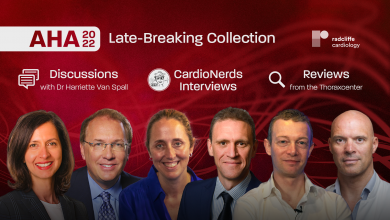Search results
Author(s):
Jonathan Piccini
Added:
1 year ago
AHA 22 - Dr Jonathan Piccini(Duke University Medical Center, Durham, US) joins us to discuss the findings of the NOVA Phase II trial (NCT03779841).
NOVA Phase II is a multicenter, randomized, dose-ranging study that aims to find the efficacy and safety of botulinum toxin type A (AGN-151607) (AbbVie)in preventing post-operative atrial fibrillation (POAF) in patients undergoing open-chest cardiac…
View more
Upstream Treatment of Atrial Fibrillation with n-3 Polyunsaturated Fatty Acids: Myth or Reality?
Author(s):
Francesco Orso
,
Gianna Fabbri
,
Aldo Pietro Maggioni
Added:
3 years ago
Article
AHA 22 Late-Breaking Science Coverage
Video Series
Author(s):
David Hamon
,
Jane Taleski
,
Marmar Vaseghi
,
et al
Added:
3 years ago
Orthotopic heart transplantation (OHT) is the most effective long-term therapy for end-stage heart disease, with implanted left ventricular assist devices (‘destination therapy’) as an alternative for selected patients. The denervation of the transplanted heart with complete loss of autonomic nervous system modulation, the use of immunosuppressant drugs, as well as the risk of allograft rejection…
View more
Atrial Myopathy Underlying AF
Author(s):
Harold Rivner
,
Raul D Mitrani
,
Jeffrey J Goldberger
Added:
3 years ago
Article
Author(s):
Amaar Hassan
,
Gregory YH Lip
,
Laurent Fauchier
,
et al
Added:
3 years ago
Author(s):
Yousif Ahmad
,
Gregory YH Lip
Added:
3 years ago
Atrial fibrillation (AF) leads to a prothrombotic state1 and places patients at risk of thromboembolic disease. The most common and serious complication of thromboembolism is stroke, and AF is held responsible for 25 % of all strokes.2 Strokes in the context of AF are associated with a higher mortality, longer hospital stay and lower levels of independence at discharge.3 These factors combine to…
View more
Author(s):
Axel Brandes
,
Marcelle D Smit
,
Bao Oanh Nguyen
,
et al
Added:
3 years ago
Atrial fibrillation (AF) is the most common clinical arrhythmia worldwide and is expected to increase in the coming decades.1,2 It currently affects up to 3 % of Western populations aged 20 years or older, and the number of affected individuals in the EU will increase from about 7 million to almost 13 million by 2030.3–5 This growing epidemic is not only caused by the natural ageing of the…
View more
Author(s):
Amit J Thosani
,
Paul Gerczuk
,
Emerson Liu
,
et al
Added:
3 years ago
Atrial fibrillation (AF) is the most common cardiac arrhythmia worldwide. In 2010, the prevalence of AF in the US was estimated at 5.9 million.1 The decision to pursue treatment to maintain sinus rhythm is driven by disabling symptoms related to AF; including palpitations, dyspnoea, fatigue, stroke and congestive heart failure. Percutaneous catheter-based ablation is an established therapy for…
View more
Author(s):
Christian Mahnkopf
,
Younghoon Kwon
,
Nazem Akoum
Added:
2 years ago
















